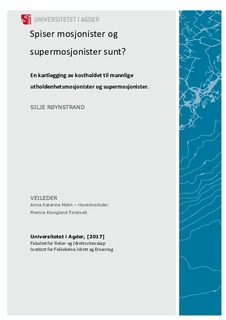| dc.description.abstract | Background: To achieve the optimal recovery between workouts and best
possible performance at training and in competitions, an optimal diet is essential
for athletes at all levels. Previous studies have focused on the nutritional status
of female athletes and few studies have researched the dietary habits and
possible negative consequences of an insufficient diet in male athletes.
Purpose: The main purpose of this study was to characterize the dietary intake
of a group endurance-trained man and, on the basis of their physical fitness,
compare their diets to the energy and nutrition recommendations developed by
Helsedirektoratet or Olympiatoppen.
Method: Forty-nine male endurance athletes participated in this study. They
were divided into two groups; trained (n=22) and well-trained (n=27) based on
their VO2max score. The participants weighed and registered their diets over a
time period of 3-4 days, in which time they also registered all physical activity.
Physical health- and performance tests, as well as anthropometrical test were
preformed to describe the participants on a group level. Results: Thirty-five participants had reduced energy availability (<40
kcal/kg/day) and 43 participants had an energy intake <50 kcal/kg/day. Intake
of protein, total fat, dietary fiber and meal frequency was for both groups, within
the recommendations for their respective group. The carbohydrate intake of the
well-trained group was within the recommendations from Olympiatoppen set to
days with moderate training (5-7 gram/kg/day), but did not accommodate days
with high-intensity training (6-10 gram/kg/day). The carbohydrate intake of the
trained group did not comply with the recommendations from Helsedirektoratet.
Conclusion: Overall the participants had a diet that met the recommendations
compiled for their group. The participants energy intake was however lower
than recommended, which resulted in reduced energy availability. Their intake
of carbohydrate was also lower than recommended. Both the trained and welltrained
group met the recommendations for dietary fiber and a positive
association was found between total energy intake (kcal/day) and dietary fiber,
but not between kcal/kg/day and dietary fiber. Furthermore, increasing
amounts of fruit, berries and vegetables, as well as generally more healthy food
choices, could increase the intake of necessary nutrients. Both groups eat a
sufficient amount of meals during the day.
Key words: Sports nutrition, Well-trained, exerciser, diet, endurance athlete,
physical activity | nb_NO |

